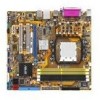Asus M2A VM M2A-VM Premium user's manual - Page 70
USB Configuration
 |
UPC - 610839149438
View all Asus M2A VM manuals
Add to My Manuals
Save this manual to your list of manuals |
Page 70 highlights
OnBoard LAN Boot ROM [Disabled] Allows you to enable or disable the onboard LAN boot ROM. Configuration options: [Disabled] [Enabled] Serial Port1 Address [3F8/IRQ4] Allows you to select the Serial Port1 base address. Configuration options: [Disabled] [3F8/IRQ4] [2F8/IRQ3] [3E8/IRQ4] [2E8/IRQ3] [Auto] Parallel Port Address [378/IRQ7] Allows you to select the Parallel Port address. Configuration options: [Disabled] [378/IRQ7] [278/IRQ5] [3BC/IRQ7] Parallel Port Mode [EPP] Allows you to select the Parallel Port mode. Configuration options: [Normal] [EPP] [ECP] [Bi-Directional] The "ECP Mode Use DMA" item becomes user-configurable when the Parallel Port Mode item is set to [ECP] or [Bi-Directional] ECP Mode Use DMA [3] Allows selection of ECP Mode. Configuration options: [1] [3] 2.4.5 USB Configuration The items in this menu allows you to change the USB-related features. Select an item then press to display the configuration options. Advanced Phoenix-Award BIOS CMOS Setup Utility USB Configuration USB Controller USB EHCI Controller USB Legacy support [Enabled] [Enabled] [Enabled] Select Menu Item Specific Help USB Controller [Enabled] Allows you to enable or disable the USB controller. Configuration options: [Disabled] [Enabled] USB EHCI Controller [Enabled] Allows you to enable or disable the onchip USB controller. Configuration options: [Disabled] [Enabled] USB Legacy Support [Enabled] Allows you to enable or disable support for USB devices on legacy operating systems (OS). Configuration options: [Disabled] [Enabled] 2-26 Chapter 2: BIOS setup















